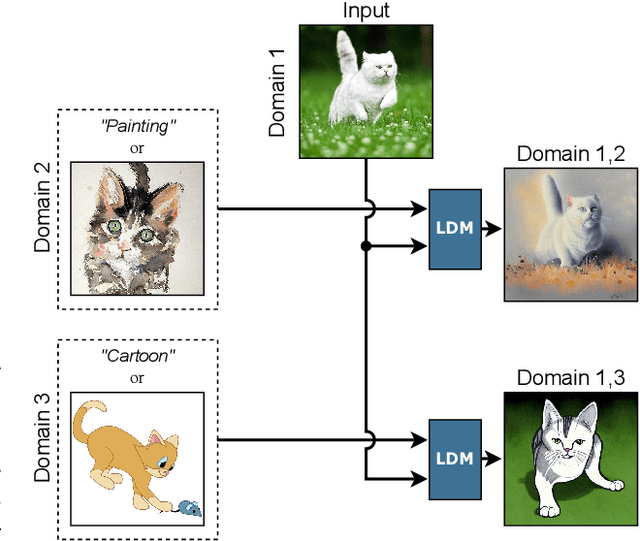Bassel Al Omari
Cross Domain Generative Augmentation: Domain Generalization with Latent Diffusion Models
Dec 08, 2023



Abstract:Despite the huge effort in developing novel regularizers for Domain Generalization (DG), adding simple data augmentation to the vanilla ERM which is a practical implementation of the Vicinal Risk Minimization principle (VRM) \citep{chapelle2000vicinal} outperforms or stays competitive with many of the proposed regularizers. The VRM reduces the estimation error in ERM by replacing the point-wise kernel estimates with a more precise estimation of true data distribution that reduces the gap between data points \textbf{within each domain}. However, in the DG setting, the estimation error of true data distribution by ERM is mainly caused by the distribution shift \textbf{between domains} which cannot be fully addressed by simple data augmentation techniques within each domain. Inspired by this limitation of VRM, we propose a novel data augmentation named Cross Domain Generative Augmentation (CDGA) that replaces the pointwise kernel estimates in ERM with new density estimates in the \textbf{vicinity of domain pairs} so that the gap between domains is further reduced. To this end, CDGA, which is built upon latent diffusion models (LDM), generates synthetic images to fill the gap between all domains and as a result, reduces the non-iidness. We show that CDGA outperforms SOTA DG methods under the Domainbed benchmark. To explain the effectiveness of CDGA, we generate more than 5 Million synthetic images and perform extensive ablation studies including data scaling laws, distribution visualization, domain shift quantification, adversarial robustness, and loss landscape analysis.
ASAP: Automated Sequence Planning for Complex Robotic Assembly with Physical Feasibility
Sep 29, 2023Abstract:The automated assembly of complex products requires a system that can automatically plan a physically feasible sequence of actions for assembling many parts together. In this paper, we present ASAP, a physics-based planning approach for automatically generating such a sequence for general-shaped assemblies. ASAP accounts for gravity to design a sequence where each sub-assembly is physically stable with a limited number of parts being held and a support surface. We apply efficient tree search algorithms to reduce the combinatorial complexity of determining such an assembly sequence. The search can be guided by either geometric heuristics or graph neural networks trained on data with simulation labels. Finally, we show the superior performance of ASAP at generating physically realistic assembly sequence plans on a large dataset of hundreds of complex product assemblies. We further demonstrate the applicability of ASAP on both simulation and real-world robotic setups. Project website: asap.csail.mit.edu
 Add to Chrome
Add to Chrome Add to Firefox
Add to Firefox Add to Edge
Add to Edge